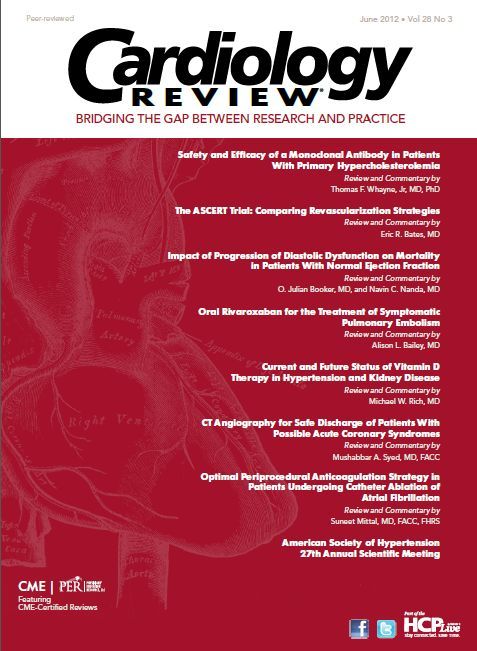Publication
Article
Cardiology Review® Online
Heat and Light

Debabrata Mukherjee, MD, MS, FACC
Editor-in-Chief
The hot summer days are upon us—at least here in Texas—and in this issue of Cardiology Review we cover several sizzling topics.
Dr Eric Bates discusses the optimal revascularization strategy for patients with stable ischemic heart disease. He opines that as we move closer to patient-centered care, it is important to remember that all coronary revascularization decisions are complex and need to be individualized. Rather than continuing the debate on revascularization superiority, PCI and CABG should be viewed as complementary strategies and valued as equally important for stable ischemic heart disease treatment options.

Dr Alison Bailey reviews the role of rivaroxaban for the treatment of symptomatic pulmonary embolism. In the past few years, multiple new oral anticoagulants have been developed. Most of these drugs focus on directly inhibiting either Factor Xa (rivaroxaban, apixaban, edoxaban) or thrombin (dabigatran). Dr. Bailey concludes that there are multiple benefits associated with these drugs, including ease of administration (oral versus intravenous or subcutaneous), no need for routine monitoring, and improved safety profiles (driven mostly by a reduction in major bleeding episodes). The major drawbacks include cost and the irreversible nature of most of these drugs. However, with currently expanding indications (prophylaxis and treatment of DVT and PE, thromboembolism prophylaxis in AF) and the lack of enthusiasm for coumadin, these medicines are likely to gain a larger share of the antithrombotic market.
Dr O. Julian Booker discusses the impact of the progression of diastolic dysfunction on mortality in patients with normal ejection fraction and recommends that moderate or severe diastolic dysfunction should be treated by aggressive risk-factor modification. The increase in mortality associated with all levels of diastolic dysfunction extends the use of medical therapy for the treatment of even mild dysfunction, specifically the use of statins. Among other imaging modalities, Dr Mushabb ar Syed reviews CT angiography for safe discharge of patients with possible acute coronary syndromes, and states that based on the currently available evidence, a CCTA-based strategy is a reasonable alternative to traditional stress testing in patients with lowto intermediate-risk acute chest pain.
Dr Sunee t Mittal discusses optimal periprocedural anticoagulation strategy in patients undergoing catheter ablation of atrial fibrillation and suggests that available data provide support for the notion that ablation during continued therapeutic anticoagulation with warfarin is the optimal strategy in patients undergoing catheter ablation of AF.
Dr Michael Rich reflects on the status of vitamin D therapy in hypertension and kidney disease. He provides some practical advice to clinicians, stating that for those not at risk for osteoporosis, there is no evidence that taking vitamin D is beneficial; however, it’s probably not harmful at modest dosages such as 1000 to 2000 IU per day, and is therefore OK to take if desired. Dr Thomas Whayne discusses a novel therapy: a monoclonal antibody in patients with primary hypercholesterolemia. He concludes that the potential of this therapy is exciting and offers an additional, promising approach to possibly improve the lives of patients at risk for, or ravaged by, atherosclerotic disease. Finally, in our new section on diabetes and heart disease, Dr Peter Jones discusses our national obsession: namely, weight loss, and provides many insightful and practical suggestions for a healthy approach to this problem.
I hope that you will find these commentaries to be valuable and enjoyable. Also, the insightful compilation of current news and trends by our managing editor, Ms Jackie Syrop, should keep you updated on the latest happenings in the field of medicine. I encourage you to share your insights, thoughts, and personal experiences on the topics touched upon in this issue. On a broader level, I would love to hear feedback on how we can make this journal even better. My goal continues to be to make you look forward to every issue of Cardiology Review.
